|
80x5 -
240x3 -
240x4 -
320x1 -
320x2 -
320x3 -
640x1 -
640x2
Set display option above.
Click on
images to enlarge. |
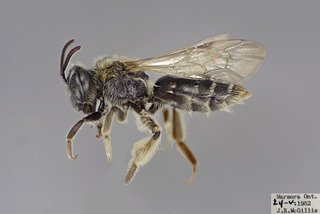
© Copyright Laurence Packer 2014
· 7
Andrena spiraeana FEM CFP comp |
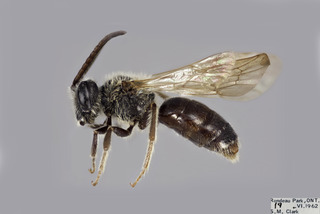
© Copyright Laurence Packer 2014
· 7
Andrena spiraeana MALE CFP comp |
|

© Copyright source/photographer
· 5
Andrena spiraeana, f, back, Prince Georges Co, MD |
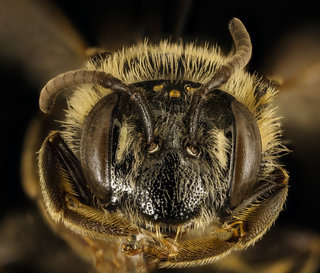
© Copyright source/photographer
· 5
Andrena spiraeana, f, face, Prince Georges Co, MD |
|
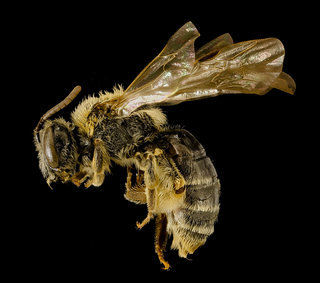
© Copyright source/photographer
· 5
Andrena spiraeana, f, side, Prince Georges Co, MD |
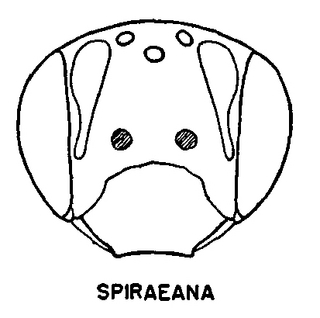
Mitchell, Bees of the Eastern United States, Vol. I, 1960 · 1
Andrena spiraeana, figure35e |
|
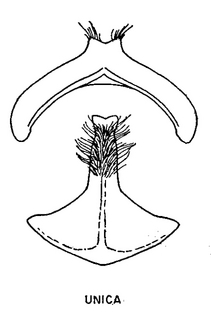
Mitchell, Bees of the Eastern United States, Vol. I, 1960 · 1
Andrena spiraeana, figure36g |
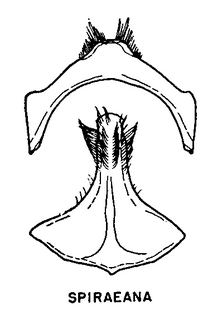
Mitchell, Bees of the Eastern United States, Vol. I, 1960 · 1
Andrena spiraeana, figure38b |
|
Overview |
Reprinted with permission of the American Entomological Society from:
LaBerge, W. E. 1973. A revision of the bees of the genus Andrena of the Western Hemisphere. Part VI. Subgenus Trachandrena. Transactions of the American Entomological Society 99: 235-371.
Please report text errors to: leah at discoverlife dot org.
This distinctive eastern species is related to both A. rugosa and A. miranda. As in rugosa, the female of spiraeana has the terga with the apical areas at least twice as long medially as the basal area (usually longer at least on tergum 2). The female of spiraeana is distinctive in the form of the facial fovea which has an extremely narrow lower portion (half as wide as upper part or less) and which is directed outwards toward the compound eye so that on a line measured from the inner margin of the antennal fossa to the compound eye there is more space between the fossa and the fovea than from the inner margin of the fovea to the inner eye margin. The face of the female above the antennal fossae is shiny, punctate, without rugae or with only weakly formed, irregular rugae (especially near the foveae). The male is less readily recognized and is most easily confused with that of virginiana from which it can be separated by the shorter first flagellar segment (relative to the second segment) and the less obviously punctate, moderately shagreened, lateral genal areas. The vertex of both sexes is short, unlike that in miranda, and the terga (especially the first) are usually sparsely punctate and shiny.
FEMALE. MEASUREMENTS AND RATIOS. � N = 20; length, 8-11 mm; length, 2.5-3.0 mm; wing length, M = 3.69 � 0.107 mm; FL/FW, M = 1.06 � 0.004; FOVL/FOVW, M = 3.88 � 0.063.
INTEGUMENTAL COLOR. � Black except as follows: mandible with apical half or more rufescent; flagellar segments 2-10 reddish-brown to dark brown below; tegulae dark reddish-brown; wing membranes hyaline, slightly yellowed or colorless, veins reddish-brown to dark brown; terga often with slight rufescent reflections in apical areas; distitarsi and often basitarsi and tibiae dark rufescent.
STRUCTURE. � Antenna as in sigmundi but second flagellar segment shorter than third and broader than long. Eyes each about 3.7 times as long as broad, inner margins slightly diverging towards mandibles or parallel. Malar space, mandible and galea as in sigmundi. Maxillary palpus as in sigmundi but segmental ratio about as 0.9:1.0:0.9:0.7:0.7:0.7. Labial palpus as in sigmundi but ratio about as 1.0:0.5:0.5:0.6. Labral process as in sigmundi; labrum apical to process not sulcate, with several extremely weak cristae. Clypeus with round coarse punctures separated mostly by half to one puncture width, median line impunctate or usually so; surface shiny, unshagreened. Supraclypeal area strongly raised, rounded; punctures small, separated by one puncture width; surface shiny, unshagreened. Genal area with small round punctures separated by one-half to two puncture widths (more crowded near eye margins); surface shiny, unshagreened or finely so especially posteriorly; ventrally rugulose as in sigmundi. Vertex as in sigmundi but punctures sparse, usually one or two rows above lateral ocelli (but punctures smaller than in virginiana). Face above antennal fossae usually without rugae, smooth and shiny with round punctures separated by one-half to one puncture width or more (occasionally fine rugae present especially laterally near facial foveae and rarely over entire surface). Facial foveae separated from lateral ocellus by one-half to three-fourths of an ocellar diameter; lower portion extremely narrow (equal to half or less width of upper portion), slanted towards eye margin below; space between facial fovea and outer margin antennal fossa distinctly greater than from outer margin of fossa to eye margin at same level; greatest space between fovea and eye margin equals fovea at that level or slightly more.
Pronotum as in sigmundi but surface shiny especially above. Mesoscutum with large, round, deep punctures separated by one-half to one or more puncture widths (punctures larger than in sigmundi but smaller than in rugosa and much as in virginiana); surface shiny, shagreening fine and usually peripheral if present. Scutellum similar to mesoscutum but punctures slightly larger and more crowded. Metascutum with punctures contiguous. Propodeum as in sigmundi but dorsal surface outside of enclosure and posterior surface coarsely reticulorugose. Mesepisternum as in rugosa. Posterior hind tibial spur normal. Pterostigma and wing venation as in sigmundi.
Metasomal terga as in rugosa except as follows: tergum 1 with basal area usually almost devoid of punctures except along midline (considerable variation exists from punctures separated mostly by two puncture widths to punctures separated by six or seven puncture widths or more), apical area usually more densely punctate, but occasionally also almost impunctate; terga 2-4 with apical area punctures often sparse, minute; surfaces usually unshagreened or only delicately so. Pygidial plate and sterna as in sigmundi but pygidial plate less truncate and more rounded apically.
VESTITURE. � Generally white except yellowish on vertex and thoracic dorsum. Form and distribution of hairs as in rugosa except as follows; dorsum of thorax with hairs longer, not thickened; tergum 4 with sparse but complete apical fringe; tergum 3 with apical area hairs sparse, usually fringing tergum except laterally and narrowly interrupted medially; fine facial foveal hairs pale.
MALE. MEASUREMENTS AND RATIOS. � N = 20; length, 7-9 mm; width, 1.5-2.4 mm; wing length, M = 3.17 � 0.150 mm; FL/FW, M = 1.16 � 0.005; FS1/FS2, M = 0.60 � 0.012.
INTEGUMENTAL COLOR. � Black with same exceptions as female.
STRUCTURE. � Antenna long; scape length equal to first two flagellar segments or slightly more; flagellar segments as in forbesii; surface dull. Eyes each about three and one-fourth times as long as broad, inner margins converging slightly towards mandibles or parallel. Malar space, mandible and galea as in female (see sigmundi). Maxillary and labial palpae as in female. Labrum as in sigmundi. Clypeus as in female but punctures smaller and more crowded and median impunctate line narrower or absent. Supraclypeal area discretely punctate, punctures separated by half a puncture width or slightly more (occasionally more crowded), surface shiny. Vertex above lateral ocellus equals one ocellar diameter or slightly less; surface dull, finely tessellate, sparsely punctate laterally. Face above antennal fossae with weak longitudinal rugulae and distinct interrugal punctures; surface moderately shiny. Genal area laterally about as broad as eye, with distinct punctures as in female but with fine longitudinal rugulae and fine shagreening moderately dulling surface especially in posterior half.
Pronotum as in female. Mesoscutum with distinct, round, deep punctures separated by half a puncture width anteriorly and laterally, sparser posteromedially, surface shiny, shagreened only peripherally, if at all. Scutellum and metanotum similar but punctures larger and crowded, moderately dulled by fine shagreening. Propodeum and mesepisternum as in rugosa. Tibial spurs normal. Wing venation as in sigmundi.
Metasomal terga as in rugosa but punctures usually sparser and surfaces shiny, unshagreened; tergal apical areas (especially terga I and 2) equal in length to basal areas or almost so. Sterna as in sigmundi but punctures extremely sparse and surfaces often shiny, shagreening delicate or absent. Sternum 6 emarginate apically. Terminalia as in sigmundi; see figures 53-54.
VESTITURE. � Generally white to pale ochraceous but often yellow on vertex and thoracic dorsum; terga 2-4 with pale apical fasciae of weakly plumose, silky hairs fringing terga, broadly interrupted medially on 2 and 3, narrowly interrupted on 4 and usually complete on tergum 5.
REMARKS. � Mitchell (1960) named A. montensis from a short series of females from western North Carolina. These females are marked by more densely punctate terga (especially the base of tergum 1) and slightly larger size than is normal. Such individuals appear throughout the range of spiraeana and there does not seem to be justification for recognizing this name for either a geographical race or a separate species. Mitchell also described a male from Ithaca, New York, as A. unica. This male appears to be a male of spiraeana except that it is large (but within the size variation of spiraeana that the present author has found to exist) and the hidden sterna have slightly different shape. It is also possible that this specimen is a variant of A. miranda rather than spiraeana, but features of the antennae and sculpture indicate that it belongs with spiraeana.
Reprinted with permission from: Mitchell, T.B. 1960. Bees of the Eastern United States. North Carolina Agricultural Experiment Station Technical Bulletin No. 141.
FEMALE. � Length 10 mm.; clypeus broadly convex, projecting about one-third below suborbital line, smooth and shining between deep, distinct, rather coarse and close punctures, these somewhat separated toward middle; facial foveae broad above, occupying most of space between eyes and ocelli, covered with silvery tomentum, abruptly and strongly constricted below, this portion not more than one-third width of upper portion and remote from eye margin by a nearly equal space; space between margin of vertex and lateral ocelli somewhat greater than their diameter, but less than distance between the ocelli; cheeks subequal to eyes in width, smooth and shining, very finely and rather closely punctate, punctures becoming more sparse, coarse and deep on vertex laterally; malar space extremely short; basal segment of flagellum slightly shorter than 2nd and 3rd combined; process of labrum rather large, subtriangular, apex rather broadly truncate; pubescence of head whitish, becoming faintly yellowish above, that on thorax whitish-ochraceous below, more yellowish above, that on legs pale ochraceous; punctures of scutum rather coarse, deep and distinct, well separated anteriorly, becoming somewhat more sparse in center posteriorly, the surface somewhat shining, those on scutellum slightly more coarse and close, with only very narrow intervening spaces; pleura coarsely rugose; dorsal area of propodeum oblique, triangle quite coarsely and regularly striate; propodeal corbicula short, without a distinct anterior fringe, pale ochraceous; trochanteral floccus rather poorly developed, short, whitish; hind tibiae somewhat broadened apically, apex about twice width of basitarsi which are rather narrow, scopa rather dense, hairs simple, rather short, entirely pale ochraceous, fore and mid basitarsi slightly narrower than their respective tibiae; 2nd submarginal cell somewhat shorter than 3rd, receiving 1st recurrent about one-third from apex; abdominal terga smooth, shining, apical impressed areas shallow, minutely and rather sparsely punctate, rims nearly concolorous with remainder of discs, occupying medially about two-thirds length of disc, basal portions of discs finely and rather closely and deeply punctate, discal pubescence very short, thin, erect, entirely pale, terga 2-4 with narrow, whitish, apical fasciae, widely interrupted on 2 and 3, tergum 5 with a golden-brown, apical fimbria.
MALE. � Length 7 mm.; clypeus convex, projecting about one-third below suborbital line, smooth and shining between coarse, close, deep and distinct punctures, these only very slightly separated medially; space between margin of vertex and lateral ocelli somewhat greater than their diameter, but less than distance between them; cheeks subequal to eyes in width, rounded posteriorly, rather dull, very finely and obscurely substriate, but with some obscure, minute punctures along margin of eyes, becoming nearly impunctate on vertex laterally, which is finely tessellate; malar space extremely short; basal segment of flagellum very short, no longer than broad, much shorter than 2nd and following segments; process of labrum subtriangular, apex rather broadly truncate; mandibles with a distinct, inner, subapical tooth, overlapping but very slightly; pubescence of head, thorax and legs pale ochraceous; punctures of scutum deep, distinct, coarse and close anteriorly, becoming somewhat more widely separated in center posteriorly, those on scutellum about equally coarse but irregular, interspaces rather densely tessellate; pleura coarsely rugose; dorsal area of propodeum oblique, triangle coarsely and rather irregularly striate; basitarsi slender and elongate, considerably narrower than their respective tibiae; 2nd submarginal cell rather narrow, receiving 1st recurrent about one-third from apex; abdominal terga shining, apical impressed areas rather shallow, occupying medially not quite half length of disc, punctures very minute and rather sparse, those on the more basal portions somewhat deeper and more distinct, rather fine, well separated, apical rims becoming obscurely reddened, discal pubescence very short, thin, suberect, apparently entirely pale, fasciae very poorly developed, if at all; apical portion of sternum 8 slender, with a rather deep subapical constriction, apex somewhat rounded, clothed beneath with rather dense, pale pubescence; penis valves slender apically, slightly dilated basally, deeply excavated laterally, gonocoxites abruptly dilated apically, rather deeply concave, gonocoxal lobes strongly produced, subtriangular, narrowly rounded apically, nearly attaining apical lobes (similar to hippotes, fig. 37).
DISTRIBUTION. � Minnesota to the New England states, south to Tennessee and South Carolina; April to August.
FLOWER RECORDS. � Aruncus, Azalea, Hydrangea and Rhus. Robertson (1929) records spiraeana also on Cryptotaenia, Heracleum and Ptelea.
Described using the synonymous name: Andrena montensis Mitchell
FEMALE. � Length 10 mm.; face slightly longer than distance between eyes; eyes about parallel; foveae abruptly and narrowly constricted below, this area separated from eye margin by about an equal space; vertex rather broad, lateral ocelli separated from its hind margin by a space somewhat greater than their diameter; cheeks slightly broader than eyes; clypeus protruding very slightly below suborbital line, rather smooth and shining, with a narrow, median, impunctate line, deeply and distinctly but rather irregularly punctate on each side of this line, both as to spacing and size of punctures; face below ocelli smooth and shining, with minute, well separated punctures, those on vertex somewhat more coarse but rather shallow and indefinite, those on cheeks minute, close but rather obscure; malar space hardly evident; process of labrum rather broadly triangular, with truncate apex, median length about half the basal width; basal segment of flagellum slightly shorter than segments 2 and 3 combined. median segments somewhat longer than broad; pubescence of head and thorax entirely pale, rather whitish laterally and beneath, becoming somewhat yellowish above, thin and erect, more dense on dorsum of thorax laterally; scutum and scutellum shining between coarse deep and rather close punctures, these not crowded anteriorly, becoming somewhat more sparse posteriorly, quite close and irregular on scutellum; pleura coarsely rugose anteriorly, becoming quite smooth posteriorly; dorsal area of propodeum rather narrow, distinctly and rather coarsely striate, more reticulate laterally., propodeal corbicula short but quite dense, with scattered, inner hairs but no anterior fringe; trochanteral floccus short; legs dark, basitarsi quite narrow, pubescence entirely pale, hind tibiae somewhat broadened apically, scopal hairs entirely whitish, quite elongate; tibial spurs testaceous; wings subhyaline, veins testaceous, stigma more ferruginous; 2nd submarginal cell about half length of 3rd, receiving 1st recurrent toward apex; tegulae piceous anteriorly, more yellowish-hyaline posteriorly and along outer rim; abdominal terga shining, segments 2-4 very broadly impressed, this area about three-fourths the total median length, punctures very fine and quite sparse on basal tergum and on impressed areas of remaining terga, the narrow basal portions with somewhat more coarse and close punctures, especially on 3rd and 4th terga, apical fasciae evident only at extreme sides on 3rd and 4th terga, apical fimbria pale brownish.
TYPES. � Holotype: Female, Grandfather Mt., Watauga Co., N. C., June 24, 1954 (Mitchell). Paratypes: NORTH CAROLINA: 4 FF, topotypical; 1 F, Cruso, Haywood Co., June 28, 1934 (on Hydrangea); 1 F Grandfather Mt., Watauga Co., July 3, 1941; 1 F Busick-Mt. Mitchell Trail, June 20, 1941; 2 FF, Doughton Park, Wilkes Co., June 24, 1948 (on Rhus) (all Mitchell); 1 F, Black Mountain, mid June, 1922 (F. Sherman). NEW YORK: 1 F, Bemus Pt., June 19, 1937 (H. K. Townes). VIRGINIA: 1 F, Arlington, May 15, 1948 (K. V. Krombein); 1 F, Glen Carlyn, June 14 (Banks). VERMONT: 1 F, Manchester, June 9, (C. W. Johnson). CONNECTICUT: 1 F, Colebrook, August 2, 1926 (W. M. Wheeler). MICHIGAN: 2 FF, East Lansing, July 11, 1937 and July 13, 1940; 1 F, Gull Lake Biol. Sta., Kalamazoo Co., June 27, 1956 (R. L. Fischer on Rhus glabra. WISCONSIN: 1 F, Boscobel, June 14, 1955 (R. W. Hodges). OHIO: 1 F, Zanesville, June 11, 1954 (R. L. Fischer on Zizia aurea)
These paratypes are located in the Museum of Comparative Zoology, the University of Michigan, the U. S. National Museum, the North Carolina Department of Agriculture, the collection of H. R. Townes, and the author's collection.
Described using the synonymous name: Andrena unica Mitchell
MALE. � Length 9 mm.; face about one-fourth longer than distance between eyes above; eyes subparallel; lateral ocelli separated from margin of vertex by a space somewhat greater than their diameter; cheeks and eyes subequal; clypeus rather strongly convex, projecting only slightly below suborbital line, rather smooth and shining between rather fine, evenly distributed and rather close punctures; face below ocelli dull, rather more tessellate than rugose, vertex dull, finely tessellate, with no evident punctures, cheeks smooth, somewhat shining, becoming very finely striate below but without evident punctures; malar space hardly evident; process of labrum broad and very short, broadly truncate, median length no more than one-third its width; basal segment of flagellum about as long as broad, 2nd and following segments much longer, nearly twice as long as broad; mandibles relatively short, with a subapical inner tooth; pubescence rather dense, entirely pale-ochraceous on head and thorax; scutum somewhat shining between rather deep, distinct and close punctures, these almost crowded anteriorly, becoming somewhat more widely separated near center of disc, scutellum dull, punctures shallow but close, rather coarse and obscure; pleura densely rugose; dorsal area of propodeum irregularly and rather coarsely striate, poorly defined, lateral areas more rugose; legs dark basally, becoming somewhat yellowish on the more apical tarsal segments, entirely pale pubescent, spurs pale yellow; wings subhyaline, veins pale testaceous, stigma more brownish-testaceous, 2nd submarginal cell very short, about one-third length of 3rd, receiving 1st recurrent near middle; tegulae piceous; abdominal terga smooth and shining, almost polished, punctures exceedingly minute, well separated but evenly distributed, segments 2-4 impressed for about half the median length, these areas almost impunctate, with only a few fine, exceedingly minute punctures invading the more basal portions, fasciae inevident; sternum 7 rather narrowly produced medially, this area with a broadly triangular emargination; sternum 8 broad basally, rather abruptly but obliquely narrowed to the apical produced portion, this with a subapical, rather deep constriction, tip more broadly truncate, this area rather long pubescent; penis valves rather short, tips quite slender, broadly dilated at base, and this area excavated laterally, gonocoxites abruptly, broadly dilated apically, hind margin of this portion transverse, tips somewhat rounded and yellowish, gonocoxal lobes well developed, acute, abruptly flexed and reaching hind margin of the gonocoxal tips (similar to hippotes, fig. 37).
TYPE - Holotype: Male, Ithaca, New York, June 5, 1947 (C. Robinson) [Cornell Univ.].
|
|
|
Identification | |
Extracted from: Charles, R. (1895). Notes on bees, with Descriptions of New Species. Transactions of the American Entomological Society Vol. 22, No. 2. pp. 115-128.
♀- Black; head broader than thorax; clypeus
shining, thinly pubescent, rather closely and strongly punctured, with a median
ridge, which is impunctate; basal process of labrum short and broad; third joint
of antenna? shorter than next two together, flagellum dull testaceous beneath ;
mesonotum and scutellum rather closely and strongly punctured, clothed with
short, thin, fulvous pubescence, metathorax strongly reticulated, the disc with
several short, slightly irregular longitudinal ridges, enclosure poorly defined laterally, but bounded by a sharp ridge at the edge of the truncation. Wings hyaline, nervures and stigma testaceous, the tegula? dull. Legs dull ferruginous, the
pubescence pale fulvous. Abdomen shining, finely and sparsely punctured, the
second segment presenting a faint fovea on each side near base ; the apical margin
depressed for about two-thirds of the segment medially, third and fourth segments depressed more than one-half, apical margins of segments 2-4 with narrow
fascia? of white pubescence, interrupted broadly on second, less so on third ; fimbria fulvous. Length 9 mm.
♂- Resembles the female, third joint of antenna shorter than fourth. Length 7 mm.
|
|
|
Names | |
|
|
| Supported by | |
Updated: 2024-04-16 06:00:20 gmt
|